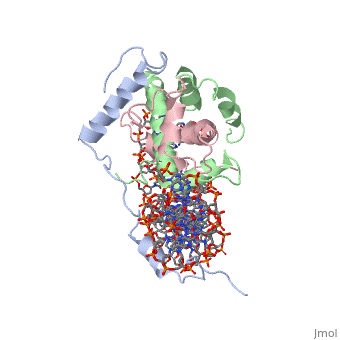NF-Y Transcription Factor Sandbox
From Proteopedia
(Difference between revisions)
| Line 11: | Line 11: | ||
<br>The NF-Y heterotrimer is stabilized by ionic interactions, interactions between the backbone atoms of residues, and hydrophobic residues. Stabilizing ionic interactions occur between Asn239(NF-YA) with Asp109(NF-YC) and Asp112(NF-YC)<ref name="mainarticle" />. Residue backbone interactions occur between Leu123(NF-YB) with Phe113(NF-YC), Arg245(NF-YA) with Glu98(NF-YB) and Glu101(NF-YB), Arg249(NF-YA) with Glu90(NF-YB), and Arg250(NF-YA) with Asp116(NF-YC)<ref name="mainarticle" />. <scene name='56/566534/Hydrophobic_residues/1'>Hydrophobic residues</scene> that contribute to the stabilization of the NF-Y heterotrimer are only located at NF-YA and NF-YB subunits at residues Ile246(NF-YA), Phe94(NF-YB), and Ile115(NF-YB)<ref name="mainarticle" />({{Template:ColorKey_Hydrophobic}} {{Template:ColorKey_Polar}}). The NF-Y heterotrimer is also stabilized by the <scene name='56/566534/A1a2_linker/2'>A1A2 linker</scene> segment through intramolecular interactions of NF-YA residues on the main chain and side chain. Along with stabilization, the A1A2 linker provides the flexibility needed to direct the NF-YA chain toward DNA<ref name="mainarticle" />. | <br>The NF-Y heterotrimer is stabilized by ionic interactions, interactions between the backbone atoms of residues, and hydrophobic residues. Stabilizing ionic interactions occur between Asn239(NF-YA) with Asp109(NF-YC) and Asp112(NF-YC)<ref name="mainarticle" />. Residue backbone interactions occur between Leu123(NF-YB) with Phe113(NF-YC), Arg245(NF-YA) with Glu98(NF-YB) and Glu101(NF-YB), Arg249(NF-YA) with Glu90(NF-YB), and Arg250(NF-YA) with Asp116(NF-YC)<ref name="mainarticle" />. <scene name='56/566534/Hydrophobic_residues/1'>Hydrophobic residues</scene> that contribute to the stabilization of the NF-Y heterotrimer are only located at NF-YA and NF-YB subunits at residues Ile246(NF-YA), Phe94(NF-YB), and Ile115(NF-YB)<ref name="mainarticle" />({{Template:ColorKey_Hydrophobic}} {{Template:ColorKey_Polar}}). The NF-Y heterotrimer is also stabilized by the <scene name='56/566534/A1a2_linker/2'>A1A2 linker</scene> segment through intramolecular interactions of NF-YA residues on the main chain and side chain. Along with stabilization, the A1A2 linker provides the flexibility needed to direct the NF-YA chain toward DNA<ref name="mainarticle" />. | ||
| - | <br>Furthermore, the NF-Y gene can be deferentially spliced to provide different isoforms of the protein. <ref name="activation" />. For example, NF-YA has two isoforms, which differ in the amount of amino acids in the glutamine (Q)-rich activation domain<ref name="activation">PMID: 22050321</ref>. The purpose of these isoforms has yet to be seen, however studies suggest that certain gene expression is dependent on which isoform is present at a time<ref name="activation" />. Another study showed that NF-YA and NF-YB is required for embryonic stem cell (ESC) viability<ref name="activation" />. | ||
== Protein Function == | == Protein Function == | ||
| Line 17: | Line 16: | ||
<p>These PTMs aid in identifying regions of DNA that are destined to be transcribed. NF-Y is responsible for recruiting enzymes responsible for transcription (like RNA Polymerase II), and enzymes involved in acetylations on active promoters, suggesting that NF-Y is involved in switch-modifications <ref name="activation" />. Furthermore, NF-Y is a sequence-specific TF. It is possible that NF-Y and other sequence-specific TFs determine histone modifications on promoters<ref name="mainarticle" />.</p> | <p>These PTMs aid in identifying regions of DNA that are destined to be transcribed. NF-Y is responsible for recruiting enzymes responsible for transcription (like RNA Polymerase II), and enzymes involved in acetylations on active promoters, suggesting that NF-Y is involved in switch-modifications <ref name="activation" />. Furthermore, NF-Y is a sequence-specific TF. It is possible that NF-Y and other sequence-specific TFs determine histone modifications on promoters<ref name="mainarticle" />.</p> | ||
<p>NF-Y is regulated by redox mechanisms<ref name="oxidativeredox">PMID: 19965775</ref>. The regulated subunit (NF-YB) has three conserved cysteines in its A2 helix: <scene name='56/566534/Cys_83/3'>C83</scene>, <scene name='56/566534/Cys_87/1'>C87</scene>, and <scene name='56/566534/Cys103/1'>C103</scene>; which sense the cellular redox potential and allow heterodimerization under reduced conditions. In oxidized conditions, NF-YB forms heterodimers in the cytoplasm which hinders CCAAT-binding and transcriptional activation<ref name="oxidativeredox" />.</p> | <p>NF-Y is regulated by redox mechanisms<ref name="oxidativeredox">PMID: 19965775</ref>. The regulated subunit (NF-YB) has three conserved cysteines in its A2 helix: <scene name='56/566534/Cys_83/3'>C83</scene>, <scene name='56/566534/Cys_87/1'>C87</scene>, and <scene name='56/566534/Cys103/1'>C103</scene>; which sense the cellular redox potential and allow heterodimerization under reduced conditions. In oxidized conditions, NF-YB forms heterodimers in the cytoplasm which hinders CCAAT-binding and transcriptional activation<ref name="oxidativeredox" />.</p> | ||
| + | |||
| + | <br>The NF-Y gene can be deferentially spliced to provide different isoforms of the protein. <ref name="activation" />. For example, NF-YA has two isoforms, which differ in the amount of amino acids in the glutamine (Q)-rich activation domain<ref name="activation">PMID: 22050321</ref>. The purpose of these isoforms has yet to be seen, however studies suggest that certain gene expression is dependent on which isoform is present at a time<ref name="activation" />. Another study showed that NF-YA and NF-YB is required for embryonic stem cell (ESC) viability<ref name="activation" />. | ||
===DNA Interaction=== | ===DNA Interaction=== | ||
Revision as of 14:37, 7 November 2013
| |||||||||||

